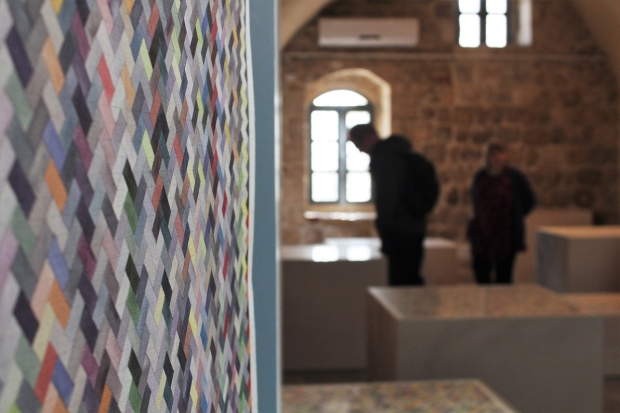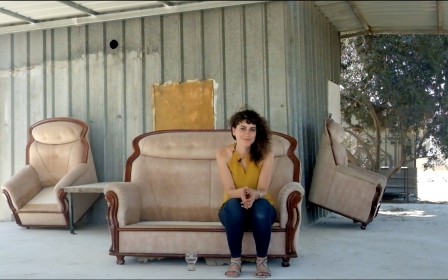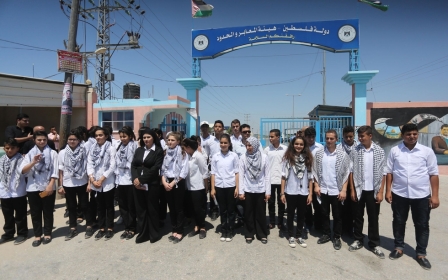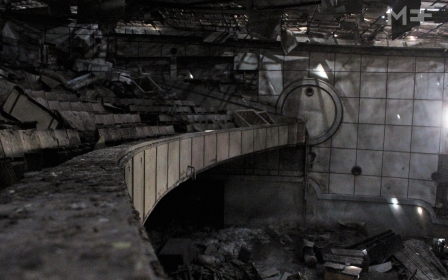Layers of history: New life for Jerusalem's forgotten artisan tiles
JERUSALEM - On a quiet Friday morning in the Old City of Jerusalem, Issa Kassissieh darted around the basement of the Al Ma’mal Foundation for Contemporary Art.
“Here were the different pots of colours," he said, pointing to a wall by the stairway, making a pouring motion with his hands as though he was tipping paint out of a jar.
“And a worker used to fill the tile frames with all the colours, and then with the cement. After shaking it and moving it, it went to a pressure machine and we would count for three minutes: tick, tick, tick,” he added.
The tile was then ready for washing and polishing.
Eagle-eyed visitors to Al Ma’mal, which opened two years ago in the Christian quarter, will notice a subtle stone sign hanging over the building’s glass doors. Written in Arabic and English, it hints at the building’s former life: “Tiles Factory, Est. 1900.” Along the bottom, there is a name: Issa Khalil Kassisieh.
Kassisieh, in his early fifties, has spent much of his life in this stone building, which borders the Latin Patriarchate.
He shares his name with his grandfather, who ran the family’s traditional handmade tile business throughout the 20th century.
Even as a child he played a role in the family-run factory, by waking up early before school and clearing the narrow driveway to welcome lorries carrying tonnes of cement.
Today, few of the flagstone tiles are left in the historic building, but this spring a new exhibition by 34-year-old Armenian Jerusalemite artist Benji Boyadgian merges his practice with the legacy of the Kassissieh family, and the distinctly Palestinian heritage of their tiles.
History repeating itself
With their intricate floral and geometric designs, rendered in bold pigments, there is a heaviness to the traditional Palestinian tiles that were arranged to create tile "carpets" throughout homes in all of Palestine. The tiles reached the height of their popularity among bourgeois Jerusalemites in the 1930s and 40s.
In West Jerusalem areas such as Katamon and Baka, where the Israeli state caused hundreds of thousands of Palestinians to lose their homes and become refugees in 1948, during what is known as the Nakba (Catastrophe), the tiles remain a testament to the Palestinians who once populated the now-Israeli neighbourhoods.
“The tiles, as I see them, are part of the identity of the Palestinian Jerusalemites,” Kassissieh said. “You see how beautiful the pre-1948 Palestinian houses were, how creative we were. But because of the occupation things have stopped in the Holy Land, in Palestine, and we have lost a lot, including heritage and creativity,” he added.
'Because of the occupation things have stopped in the Holy Land, in Palestine, and we have lost a lot, including heritage and creativity'
- Issa Kassissieh, Palestinian ambassador to the Holy See
The family was also forced to close the factory in the 1970s, when the Jerusalem Municipality began closing down industrial buildings in the Old City. Israeli jurisdiction over property rights severely limited industrial building use and transport within the Old City walls, and new taxation regulations that crippled Palestinian businesses were imposed.
The demand on handcrafted ornamental tiles dropped in the late 20th century, due to the development of cheaper, mass-produced plain tiles that were made overseas and imported from countries such as China and India. This eventually made the homemade tiles obsolete.
“It has become almost impossible to keep a factory functioning in the Old City, with all the obstacles, impediments, and the restrictions,” Kassissieh said.
“As a family, we started to face the difficulties after the 1967 war, and commercially, we couldn’t compete with the new style of machinery-produced tiles and marbles," he added.
Boyadgian was familiar with the Kassissieh tile factory’s legacy in the Old City. For the past six years, the architect-turned-artist has immersed himself in ornamental tile design, researching the rise and fall of industrial tile production over the 20th century.
'The Discord'
Boyadgian’s first solo exhibition at Al Ma’mal, entitled The Discord, is full of these patterns, but instead of painting with the substantial pigments used in traditional tile work, he turned instead to watercolour.
His paintings are exhibited in a series, where transparent, lightly painted flowers and lines become increasingly bolder and more defined. The layers of the tile construction, depicted on square, heavyweight paper, become a metaphor for Palestinian identity.
Viewed from one direction, the individual paintings begin as faint, ghostly shapes, and as the series continues, build up to complex, opaque designs. But viewed from the other direction, the series appears to dissolve the tile patterns - a representation of how Palestinian identity has been layered throughout history.
“I see Palestine as a place that is very layered,” Boyadgian told Middle East Eye on a recent afternoon at Al Ma’mal, shortly after giving a talk. “It’s a place with a long history of passage, where history repeats itself like a pattern.”
"It wasn’t just about painting the patterns, it was more about using the pattern to stimulate the memory, in order to project something else,” he added.
The exhibition, on display until the end of April, was co-curated by Jack Persekian and Basak Senova. Persekian is one of the founding members of Al Ma’mal, and also serves as its director. As Boyadian's work evolved, he followed the series over the past six years.
“In terms of technique, the dedication and the time and the perfectionist spirit that drove Benji in doing these paintings is something that I miss in contemporary art in Palestine,” Persekian told Middle East Eye, sitting in the centre of the gallery’s upper level.
Boyadgian’s installation is not only hung in series on the walls - the tiles are also framed on multi-level plinths throughout the gallery. The watercolour tiles face the ceiling, and visitors look down on them as they weave through the space.
'Jerusalem has this kind of interaction with time, because in a way nobody lives in the moment here'
-Benji Boyadgian, artist
“The tiles, we walk on them,” Boyadgian said matter-of-factly, gesturing to the floor.
In one corner of the gallery, a video loop projected on the wall flips through geometric shapes that grow and change. A series of mirrors, encased in a massive funnel-like sculpture, refracts light and images through Al Ma’mal’s skylight, and visitors are encouraged to inspect it from the roof and basement. For Boyadgian, the sculpture allows the viewer to meditate on the way Palestinians have been affected by the Nakba, often focusing on the past and unsure of the future.
"That's what this sculpture is about. I didn't only want pieces hung on the wall. I want for everybody to look up and down, to see that a moment is constructed on reflection of memory, and reflection of projection, he added.
From factory to foundation
In The Discord, the building plays just as much of a role as the artwork does. In the two years since it opened, Al Ma’mal has become central to the Jerusalem contemporary arts scene by hosting exhibitions, concerts, gallery talks and community events. But never before has it hosted an exhibition that relates so directly to its history.
“This is really the first site-specific exhibition at Al Ma’mal, in terms of the content, the history of the building and in terms of the installations,” Persekian said. “I really like this connection with the place and the history of the place, also the history of the family that owned and produced these tiles.”
'The tiles are part of our pride, part of our identity to prove that we are here to stay' - Issa Kassissieh, Palestinian ambassador to the Holy See
Kassissieh is especially pleased that an artist was able to formulate an exhibition around his family’s legacy, simultaneously celebrating and dissecting the notion of Palestine’s creative heritage.
“We were thinking of what to do with this big space, and it was a dilemma. But then we decided: let’s renovate it and make it a cultural centre for the Jerusalemite community.”
Today, Kassissieh chairs the foundation’s board, when he is not attending to his day job as the Palestinian ambassador to the Holy See, at the Vatican.
“I see the tiles as witness for our history, our roots. The tiles are part of our pride, part of our identity to prove that we are here to stay and to continue our identity and keep it for the future generations,” Kassissieh said.
New MEE newsletter: Jerusalem Dispatch
Sign up to get the latest insights and analysis on Israel-Palestine, alongside Turkey Unpacked and other MEE newsletters
Middle East Eye delivers independent and unrivalled coverage and analysis of the Middle East, North Africa and beyond. To learn more about republishing this content and the associated fees, please fill out this form. More about MEE can be found here.







